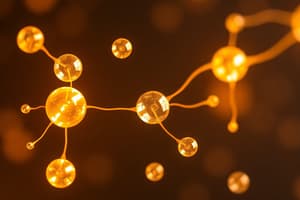Podcast
Questions and Answers
What is the formal charge of the nitrogen atom in ammonia?
What is the formal charge of the nitrogen atom in ammonia?
- -1
- 1
- 2
- 0 (correct)
What term describes a positively charged carbon ion?
What term describes a positively charged carbon ion?
- Carbocation (correct)
- Carbanion
- Cation
- Radical
Which of the following is true about the ammonia molecule?
Which of the following is true about the ammonia molecule?
- It contains a carbanion.
- It has a negative formal charge.
- It has a positive formal charge.
- It is a neutral molecule. (correct)
How many valence electrons does a hydrogen atom contribute when calculating the formal charge in ammonia?
How many valence electrons does a hydrogen atom contribute when calculating the formal charge in ammonia?
What is the anion form of the carbonate ion CO3?
What is the anion form of the carbonate ion CO3?
Which statement about resonance structures is correct?
Which statement about resonance structures is correct?
What makes a molecule positively charged when referring to ammonium?
What makes a molecule positively charged when referring to ammonium?
In terms of formal charge, how is it determined for atoms in a molecule?
In terms of formal charge, how is it determined for atoms in a molecule?
What is the significance of resonance structures in molecular stability?
What is the significance of resonance structures in molecular stability?
When considering the resonance of a molecule, which statement is true?
When considering the resonance of a molecule, which statement is true?
What is meant by resonance energy in the context of resonance theory?
What is meant by resonance energy in the context of resonance theory?
In resonance theory, which of the following statements is false?
In resonance theory, which of the following statements is false?
How does the presence of resonance structures affect the energy of a molecule?
How does the presence of resonance structures affect the energy of a molecule?
What is resonance theory and how does it relate to Lewis structures?
What is resonance theory and how does it relate to Lewis structures?
Explain why all carbon-oxygen bonds in the carbonate ion are considered equal.
Explain why all carbon-oxygen bonds in the carbonate ion are considered equal.
What is resonance energy, and why is it significant for molecular stability?
What is resonance energy, and why is it significant for molecular stability?
Why do resonance structures not exist independently in a molecule?
Why do resonance structures not exist independently in a molecule?
Describe how the number of resonance structures impacts the extent of electron delocalization in a molecule.
Describe how the number of resonance structures impacts the extent of electron delocalization in a molecule.
Explain the concept of formal charge and how it applies to molecules like ammonia.
Explain the concept of formal charge and how it applies to molecules like ammonia.
What role do cations and anions play in the formation of ionic structures within organic molecules?
What role do cations and anions play in the formation of ionic structures within organic molecules?
Discuss the importance of octet stability when considering resonance structures.
Discuss the importance of octet stability when considering resonance structures.
How does the presence of lone pairs affect the formal charge of an atom within a molecule?
How does the presence of lone pairs affect the formal charge of an atom within a molecule?
What distinguishes a carbocation from a carbanion, and what implications do these charges have?
What distinguishes a carbocation from a carbanion, and what implications do these charges have?
Explain how resonance structures can be used to depict the carbonate ion (CO3^{2-}).
Explain how resonance structures can be used to depict the carbonate ion (CO3^{2-}).
How can resonance structures be transformed, and what is the significance of this process?
How can resonance structures be transformed, and what is the significance of this process?
What is the implication of having equivalent resonance structures for a molecule's stability?
What is the implication of having equivalent resonance structures for a molecule's stability?
Flashcards
Formal Charge
Formal Charge
A measure of the distribution of electrons in a molecule, indicating the charge an atom would have if all bonding electrons were shared equally.
Carbocation
Carbocation
A positively charged carbon ion.
Carbanion
Carbanion
A negatively charged carbon ion.
Resonance Structures
Resonance Structures
Signup and view all the flashcards
Octet Rule
Octet Rule
Signup and view all the flashcards
Ionic Structures in Molecules
Ionic Structures in Molecules
Signup and view all the flashcards
Formal Charge Calculation
Formal Charge Calculation
Signup and view all the flashcards
Neutral Molecules
Neutral Molecules
Signup and view all the flashcards
What is resonance theory?
What is resonance theory?
Signup and view all the flashcards
What are resonance structures?
What are resonance structures?
Signup and view all the flashcards
Hybrid structure
Hybrid structure
Signup and view all the flashcards
Delocalization
Delocalization
Signup and view all the flashcards
Resonance Energy
Resonance Energy
Signup and view all the flashcards
Resonance Theory
Resonance Theory
Signup and view all the flashcards
Delocalization of Electrons
Delocalization of Electrons
Signup and view all the flashcards
What are ionic structures?
What are ionic structures?
Signup and view all the flashcards
Why is ammonia neutral?
Why is ammonia neutral?
Signup and view all the flashcards
Study Notes
Organic Functional Groups - Lecture 2
- Lecture 2 covers ionic structures and formal charge within molecules.
- Ionic structures can exist within molecules, consisting of cations and anions.
- The overall molecule might have a formal charge associated with it.
- Examples of neutral molecules: ammonia and water.
- Examples of charged molecules: ammonium and hydronium cations.
Formal Charge Calculation
- To calculate formal charge, subtract the number of bonded electrons from the number of valence electrons in the free neutral atom.
- Consider that in covalent bonds, electrons are shared equally, and unbonded pairs are assigned to the atom possessing them.
- The example provided is the ammonium ion.
Ammonia Neutral Charge Example
- For each hydrogen atom, the formal charge is 0 (valence electrons = 1, bonded electrons = 1).
- The nitrogen atom has a formal charge of +1 (valence electrons = 5, bonded electrons = 4).
- The overall formal charge on the ammonium ion is therefore +1.
Why is Ammonia Neutral?
- Each hydrogen atom has a formal charge of 0 (valence = 1, shared = 1).
- Nitrogen has a formal charge of 0 (valence = 5, shared = 3, unshared = 2).
- Overall formal charge is therefore 0.
Carbocation and Carbanion
- In organic molecules, ionic structures involving the carbon atom are important.
- A positively charged carbon ion is a carbocation.
- A negatively charged carbon ion is a carbanion.
Resonance
-
The Lewis structure of the carbonate ion (CO₃⁻²) presents a problem - multiple valid structures are possible.
-
These are all equivalent to each other.
-
Important considerations for Resonance are:
-
Each atom has its octet of electrons.
-
Structures can be converted by changing only electron positions.
-
A curved or curly arrow shows electron movement.
-
All three carbonate structures are equivalent, even if the C-O bond lengths are not identical in any one structure.
-
The structures are a hybrid.
Resonance Theory
-
The hybrid structure is a combination of all resonance structures, not any single one.
-
Resonance theory explains that no single structure represents the ion accurately; the actual structure is a hybrid of all possible resonance structures.
Resonance Energy
- The difference between the actual energy and expected energy of a molecule is called Resonance Energy.
- The more resonance structures, the greater the delocalization of electrons and the greater stability of the molecule.
Studying That Suits You
Use AI to generate personalized quizzes and flashcards to suit your learning preferences.





